初一英语上册知识点复习
初一英语上册语法知识点总结归纳

初一英语上册语法知识点总结归纳
- 一般现在时:表示经常发生的动作或存在的状态。
句式结构:主语+动词+其他。
当主语是第三人称单数时,动词要用第三人称单数形式。
- 现在进行时:表示正在进行或发生的动作。
句式结构:主语+be 动词+动词 ing+其他。
- 一般过去时:表示过去发生的动作或存在的状态。
句式结构:主语+动词过去式+其他。
- 一般将来时:表示将来发生的动作或存在的状态。
句式结构:主语+will+动词原形+其他,或主语+be going to+动词原形+其他。
- There be 句型:表示某地有某物或某地存在某物。
句式结构:There is/are+主语+地点状语。
- 形容词的比较级和最高级:用于比较两个或两个以上的人或事物。
比较级用于两者之间的比较,最高级用于三者或三者以上的比较。
- 代词:包括人称代词、物主代词、反身代词等,用于代替名词或起到连接作用。
- 冠词:包括定冠词 the 和不定冠词 a/an,用于修饰名词,特指或泛指某个人或事物。
- 介词:用于表示时间、地点、方位、方式等,常见的介词有 in、on、at、for、with、by 等。
- 数词:包括基数词和序数词,用于表示数量和顺序。
- 陈述句、疑问句、祈使句和感叹句:陈述句用于陈述事实或观点,疑问句用于提出问题,祈使句用于表示请求、命令、建议等,感叹句用于表示感叹语气。
人教版初中英语七年级上册语法知识点
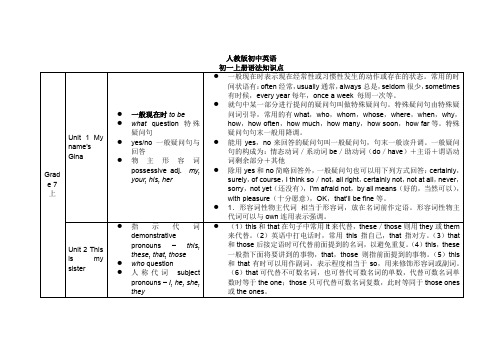
have表示“有”时,其否定形式有两种:在其后直接加not,但常用于非正式用语中;利用助动词do加not。
②如果句子的谓语是实义动词,在谓语动词前加don't,doesn't,didn't。
③no,never,seldom,hardly,nobody,little,few,nothing等否定词也可以构成否定形式。
1.表示经常性或习惯性发生的动作2.表示现在存在的状态或情况3.表示正在发生的动作或存在的状态4.表示客观事实、真理和自然现象5.用于表示较固定的、按计划、规定将要发生的动作,但只限于begin,come,go,leave,arrive,stop,return,close,open,take,start,take,place等少数动作,6.用于if,unless,once,even if(即使)等引导的条件状语从句,when,before,until,as soon as,the moment(一……就)等引导的时间状语从句,no matter+wh-/-how-或wh-ever/however等引导的让步状语从句中,代替一般将来时
人教版初中英语
初一上册语法知识点
Grade 7
上
Unit 1 My name’s Gina
初一上册英语知识点
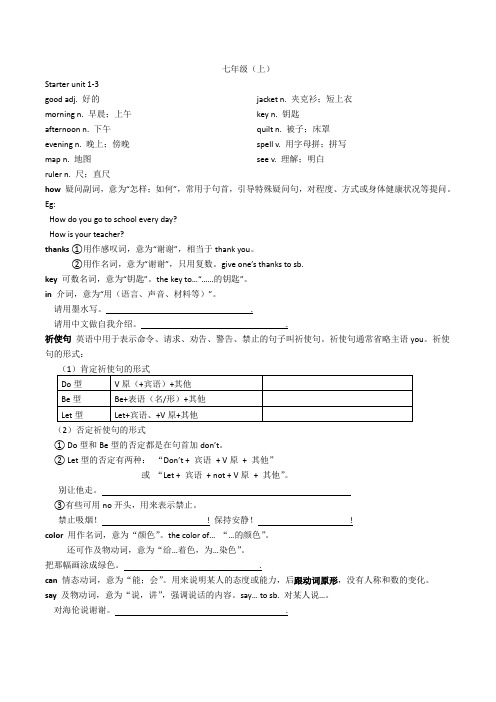
七年级(上)Starter unit 1-3good adj. 好的morning n. 早晨;上午afternoon n. 下午evening n. 晚上;傍晚map n. 地图ruler n. 尺;直尺jacket n. 夹克衫;短上衣key n. 钥匙quilt n. 被子;床罩spell v. 用字母拼;拼写see v. 理解;明白how疑问副词,意为“怎样;如何”,常用于句首,引导特殊疑问句,对程度、方式或身体健康状况等提问。
Eg:How do you go to school every day?How is your teacher?thanks①用作感叹词,意为“谢谢”,相当于thank you。
②用作名词,意为“谢谢”,只用复数。
give one’s thanks to sb.key可数名词,意为“钥匙”。
the key to…“……的钥匙”。
in介词,意为“用(语言、声音、材料等)”。
请用墨水写。
.请用中文做自我介绍。
.祈使句英语中用于表示命令、请求、劝告、警告、禁止的句子叫祈使句。
祈使句通常省略主语you。
祈使句的形式:(2)否定祈使句的形式① Do型和Be型的否定都是在句首加don’t。
② Let型的否定有两种:“Don’t + 宾语+ V原+ 其他”或“Let + 宾语+ not + V原+ 其他”。
别让他走。
③有些可用no开头,用来表示禁止。
禁止吸烟!! 保持安静!!color用作名词,意为“颜色”。
the color of…“…的颜色”。
还可作及物动词,意为“给…着色,为…染色”。
把那幅画涂成绿色。
.can情态动词,意为“能;会”。
用来说明某人的态度或能力,后跟动词原形,没有人称和数的变化。
say及物动词,意为“说,讲”,强调说话的内容。
say… to sb. 对某人说…。
对海伦说谢谢。
.no形容词,“没有;无”。
no +单数可数名词=not a/an +单数可数名词; no+不可数名词/复数名词=not any+不可数名词/复数名词。
初一上册英语各单元知识点总结
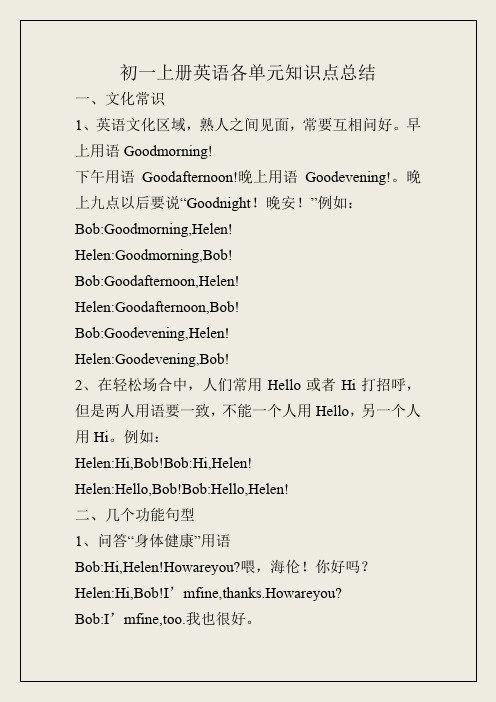
初一上册英语各单元知识点总结一、文化常识1、英语文化区域,熟人之间见面,常要互相问好。
早上用语Goodmorning!下午用语Goodafternoon!晚上用语Goodevening!。
晚上九点以后要说“Goodnight!晚安!”例如:Bob:Goodmorning,Helen!Helen:Goodmorning,Bob!Bob:Goodafternoon,Helen!Helen:Goodafternoon,Bob!Bob:Goodevening,Helen!Helen:Goodevening,Bob!2、在轻松场合中,人们常用Hello或者Hi打招呼,但是两人用语要一致,不能一个人用Hello,另一个人用Hi。
例如:Helen:Hi,Bob!Bob:Hi,Helen!Helen:Hello,Bob!Bob:Hello,Helen!二、几个功能句型1、问答“身体健康”用语Bob:Hi,Helen!Howareyou?喂,海伦!你好吗?Helen:Hi,Bob!I’mfine,thanks.Howareyou?Bob:I’mfine,too.我也很好。
对方关心你的健康,你也要询问对方的健康,而且一定要向对方说谢谢。
Howareyou?可以用简略语言:Andyou?I’mfine=I’mOK=I’mwell,表示“我很好!”Thanks=Thankyou!谢谢!2、问一个东西的“英语名字”的常用句型Helen:What’sinEnglish?用英语怎么说?↘Bob:It’sa/an+英语名称。
Helen:Spellit,please.请拼写它。
Bob:K-E-Y.3、问一个东西颜色的常用句型:Helen:Whatcolorisit?Bob:Itis+颜色。
三、1、不定冠词a与an的区别a用在辅音开头的单词前,an用在元音开头的单词前。
例如apen一支钢笔;anapple一个苹果abook一本书anhour一小时a“u”一个字母“u”anorange一个橙子;;四.指示代词this与that的区别this指代近处的人或物,that指代远处的人或物。
初一上册英语知识点总结归纳
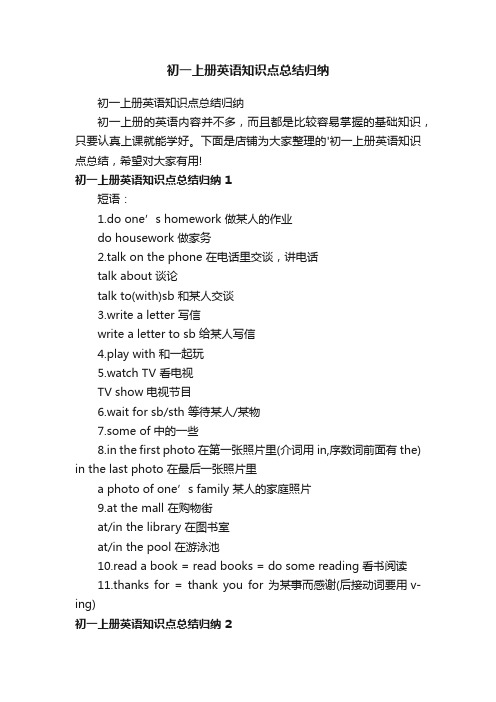
初一上册英语知识点总结归纳初一上册英语知识点总结归纳初一上册的英语内容并不多,而且都是比较容易掌握的基础知识,只要认真上课就能学好。
下面是店铺为大家整理的'初一上册英语知识点总结,希望对大家有用!初一上册英语知识点总结归纳 1短语:1.do one’s homework 做某人的作业do housework 做家务2.talk on the phone 在电话里交谈,讲电话talk about 谈论talk to(with)sb 和某人交谈3.write a letter 写信write a letter to sb 给某人写信4.play with 和一起玩5.watch TV 看电视TV show 电视节目6.wait for sb/sth 等待某人/某物7.some of 中的一些8.in the first photo 在第一张照片里(介词用in,序数词前面有the) in the last photo 在最后一张照片里a photo of one’s family 某人的家庭照片9.at the mall 在购物街at/in the library 在图书室at/in the pool 在游泳池10.read a book = read books = do some reading看书阅读11.thanks for = thank you for 为某事而感谢(后接动词要用v-ing)初一上册英语知识点总结归纳 2重点句式及注意事项:1. 他正在干什么? What is he doing?他正在吃饭。
He is eating dinner.他正在哪里吃饭? Where is he eating dinner?他正在家里吃饭。
He is eating dinner at home.2. 你想什么时候去? When do you want to go?让我们六点钟去吧。
Let’s go at six o’clock.3. 他正在等什么? What is he waiting for?他正在等公交车。
人教版初一英语知识点总结归纳上册

人教版初一英语知识点总结归纳上册一、词汇知识
掌握课本中所有单词和词组的拼写、发音和中文意思。
了解一些常用词汇的拓展词汇和固定搭配。
学习使用英语词典查找生词和词组。
二、语法知识
名词:可数名词和不可数名词,名词所有格。
代词:人称代词、物主代词、反身代词。
冠词:不定冠词a/an,定冠词the。
数词:基数词和序数词。
动词:动词时态(现在时、过去时)、动词短语。
形容词和副词:比较级和最高级。
介词:常用介词及其搭配。
连词:并列连词和从属连词。
句子类型:陈述句、疑问句、祈使句、感叹句。
句子结构:简单句、并列句、复合句。
三、听力技能
听懂与课文内容相关的对话和短文。
能根据所听内容回答问题或完成相关任务。
了解听力材料中的关键信息和细节。
四、口语技能
能模仿课文中的对话进行简单交流。
能用所学词汇和语法知识表达自己的观点和想法。
了解并遵守英语口语交际的基本礼仪。
五、阅读技能
能读懂与课文内容相关的短文和对话。
能根据所读内容回答问题或完成相关任务。
了解阅读材料中的关键信息和细节,提高阅读理解能力。
六、写作技能
能模仿课文中的例句进行简单写作。
能用所学词汇和语法知识写出简单的句子和段落。
了解并遵守英语写作的基本规范,如书写工整、标点符号使用正确等。
人教版七年级英语上册知识点总结

人教版七年级英语上册知识点总结人教版七年级英语上册学问点总结(一)1 (see 、hear 、notice 、find 、feel 、listen to 、look at (感官动词)+do eg:I like watching monkeys jump2 (比拟级and 比拟级) 表示越来越怎么样3 a piece of cake =easy 小菜一碟(简单)4 agree with sb 赞成某人5 all kinds of 各种各样a kind of 一样6 all over the world = the whole world 整个世界7 along with同一道,伴随eg : I will go along with you我将和你一起去the students planted trees along with their teachers 学生同教师们一起种树8 As soon as 一怎么样就怎么样9 as you can see 你是知道的10 ask for 求助向要(干脆接想要的东西) eg : ask you for my book11 ask sb for sth 向某人什么12 ask sb to do sth 询问某人某事ask sb not to do 叫某人不要做某事13 at the age of 在岁时eg:I am sixteen I am at the age of sixteen14 at the beginning of 的起初;的起先15 at the end of +地点/+时间最终;终点;末尾eg : At the end of the day16 at this time of year 在每年的这个时候17 be /feel confident of sth /that clause +从句感觉/对什么有信念,自信eg : I am / feel confident of my spoken English I feel that I can pass the test18 be + doing 表:1 此时此刻进展时2 将来时19 be able to (+ v 原) = can (+ v 原) 能够eg : She is able to sing She can sing20 be able to do sth 能够干什么eg :she is able to sing21 be afraid to do (of sth 恐惊,胆怯eg : Im afraed to go out at night Im afraid of dog22 be allowed to do 被允许做什么eg: Im allowed to watch TV 我被允许看电视I should be allowed to watch TV 我应当被允许看电视23 be angry with sb 生某人的气eg : Dont be angry with me24 be angry with(at) sb for doing sth 为什么而生某人的气人教版七年级英语上册学问点总结(二)25 be as原级as 和什么一样eg : She is as tall as me 她和我一样高26 be ashamed to 27 be away from 远离28 be away from 从离开29 be bad for 对什么有害eg : Reading books in the sun is bad for your eyes 在太阳下看书对你的眼睛不好30 be born 诞生于31 be busy doing sth 忙于做什么事be busy with sth 忙于32 be careful 留神;当心33 be different from 和什么不一样34 be famous for 以闻名35 be friendly to sb 对某人友好36 be from = come from 来自eg :He is from Bejing He comes from Bejing Is he from Bejing ? Does he come from Bejing ?37 be full of 装满的be filled with 充溢eg: the glass is full of water the glass is filled with water38 be glad+to+do/从句39 be going to + v(原) 将来时40 be good at(+doing) = do well in 在某方面善长, 擅长41 be good for 对什么有好处eg : Reading aloud is good for your English42 be happy to do 很开心做某事43 be helpful to sb 对某人有好处eg : Reading aloud is helpful to you 大声朗读对你有好处Exercising is helpful to your bady 熬炼对你的身体有好处44 be in good health 身体安康45 be in trouble 处于困难中eg : She is in trouble They are in tronble46 be interested in 对某方面感爱好47 be late for = come late to 迟到eg: Be late for class 上课迟到48 be like 像eg : Im like my mother49 be mad at 生某人的气50 be made from 由制成(制成以后看不见原材料)51 be made of 由制成(制成以后还看得见原材料) 52 be not sure 表不确定53 be on a visit to 参观54 be popular with sb 受某人欢送55 be quiet 静谧56 be short for 表**的缩写eg: 陶is short for 陶俊杰57 be sick in bed 生病在床58 be sorry to do sth be sorry for sb eg :I am sorry for you59 be sorry to hear that 60 be sorry to trouble sb eg : I am sorry to trouble you61 be strict in doing sth 严于做某事eg : Hes strict in obeying noles62 be strict with sb 对某人要求严格eg: Some students are not strict with them selves 这些学生对自己不严格63 be strict with sb in sth 某方面对某人严格64 be supposed to do 被要求干什么65 be sure 表确定66 be sure of doing sth 对做某事有信念eg: He is sure of winning I am sure of learning English well67 be sure of sth 对做某事有信念eg: Im sure of my head (my teacher 我坚信我的大脑(教师)68 be sure that sth 对做某事有信念eg: Im suer that he can passthe test 我坚信他能通过考试69 be sure to do sth必须会做某事eg: We are sure to pass the test 我们必须会通过这次考试We are sure to learn English well 我们必须能学好英语70 be terrified of + 名/动doing 胆怯71 be terrified to do sth 胆怯做某事73 be the same as 和什么一样73 be used to doing sth 习惯做某事eg: My father is used to getting up early 我爸爸习惯早He is used to sleeping in class 他习惯上课睡觉74 be worth doing 值得做什么75 be(feel) afraid to do sth 胆怯做某事be afraid of sth 胆怯某物be afraid that 丛句76 because+句子because of +短语eg : He was late because he had a headache He was late because of his headache77 begin to do = start to do 起先做某事startwith=beginwith 以什么起先什么eg : Lets begin the game with the song I begin to go home78 betweenand 两者之间79 borrow sth from sb 向借lend sth to sb ( lend sb sth 借给什么东西eg : I borrowed a pen from him he lent a pen to me ( he lent me apen80 both = the same(as) = not different(from) 表一样81 bother 打搅bother sb to do stheg : Im sorry to bother you ,but can you tell me to way to the station我非常致歉打搅你,但是你能告知我怎么去车站the problem has been bothering me for weeks 这个问题困扰了我几个周了Hes bothering me to lend him money82 by the end of 到为止83 call sb sth eg : We call him old wang84 care 关怀eg : Dont you care about this countrys future ?你为什么不关怀国家的将来85 catch up with sb 赶上某人86 chat with sb 和某人闲谈take sb to + 地点带某人去某地87 come in 进88 come over to 过来89 come up with 提出eg: Can you come up with a good idea 你能想出一个好方法吗?90 communicate with sb 和某人沟通看过人教版七年级英语上册学问点总结的人还看了:1.人教版英语七年级上册学问点复习2.初一上英语学问点总结3.七年级上册英语重点短语归纳4.初一英语学问点大总结5.英语七年级上册重点句型6.人教版中学英语必修七重点短语复习7.初一英语下册学问点归纳。
初一年级上册英语复习提纲【三篇】
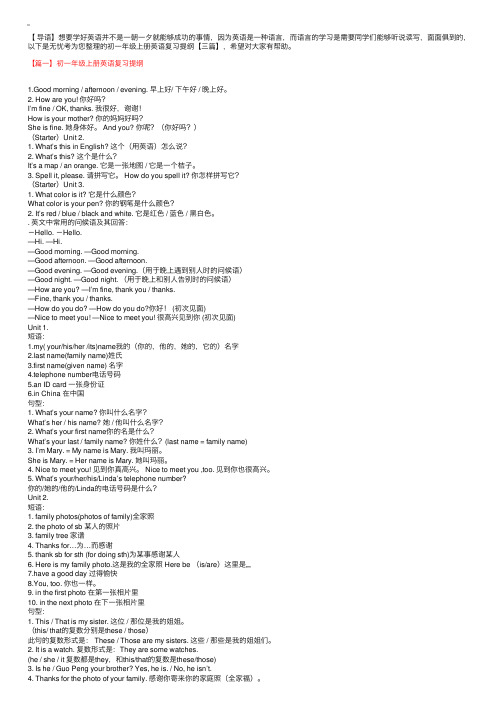
【导语】想要学好英语并不是⼀朝⼀⼣就能够成功的事情,因为英语是⼀种语⾔,⽽语⾔的学习是需要同学们能够听说读写,⾯⾯俱到的,以下是⽆忧考为您整理的初⼀年级上册英语复习提纲【三篇】,希望对⼤家有帮助。
【篇⼀】初⼀年级上册英语复习提纲1.Good morning / afternoon / evening. 早上好/ 下午好 / 晚上好。
2. How are you! 你好吗?I’m fine / OK, thanks. 我很好,谢谢!How is your mother? 你的妈妈好吗?She is fine. 她⾝体好。
And you? 你呢?(你好吗?)(Starter)Unit 2.1. What’s this in English? 这个(⽤英语)怎么说?2. What’s this? 这个是什么?It’s a map / an orange. 它是⼀张地图 / 它是⼀个桔⼦。
3. Spell it, please. 请拼写它。
How do you spell it? 你怎样拼写它?(Starter)Unit 3.1. What color is it? 它是什么颜⾊?What color is your pen? 你的钢笔是什么颜⾊?2. It’s red / blue / black and white. 它是红⾊ / 蓝⾊ / ⿊⽩⾊。
. 英⽂中常⽤的问候语及其回答:-Hello. -Hello.―Hi. ―Hi.―Good morning. ―Good morning.―Good afternoon. ―Good afternoon.―Good evening. ―Good evening.(⽤于晚上遇到别⼈时的问候语)―Good night. ―Good night. (⽤于晚上和别⼈告别时的问候语)―How are you? ―I’m fine, thank you / thanks.―Fine, thank you / thanks.―How do you do? ―How do you do?你好! (初次见⾯)―Nice to meet you! ―Nice to meet you! 很⾼兴见到你 (初次见⾯)Unit 1.短语:1.my( your/his/her /its)name我的(你的,他的,她的,它的)名字st name(family name)姓⽒3.first name(given name) 名字4.telephone number电话号码5.an ID card ⼀张⾝份证6.in China 在中国句型:1. What’s your name? 你叫什么名字?What’s her / his name? 她 / 他叫什么名字?2. What’s your first name你的名是什么?What’s your last / family name? 你姓什么?(last name = family name)3. I’m Mary. = My name is Mary. 我叫玛丽。
- 1、下载文档前请自行甄别文档内容的完整性,平台不提供额外的编辑、内容补充、找答案等附加服务。
- 2、"仅部分预览"的文档,不可在线预览部分如存在完整性等问题,可反馈申请退款(可完整预览的文档不适用该条件!)。
- 3、如文档侵犯您的权益,请联系客服反馈,我们会尽快为您处理(人工客服工作时间:9:00-18:30)。
人教版七年级英语(上册)辅导材料第一块国际音标国际音标是一种工具,其作用是标记英语字母和单词的读音。
1、20个元音单元音:/i:/Ee1、/з:/her /u:/do/I/it /ә/about /u/book/ɑ:/are //or /æ/any//us //off /e/at双元音://Ii //out //ear//Aa,//Oo //air//boy //sure2、28辅音:成对的清浊辅音:/p/map /t/it /k/book /f/off /θ/math /s/yes /b/club /d/dad /g/big /v/have /ð/this /z/zoo//fish //watch /tr/tree /ts/its//usually //orange /dr/dress /dz/beds 其他辅音:/m/am /n/and //English /l/like/h/hello /r/red /w/what /j/yes3、国际音标拼读规则:辅见元,碰一碰。
/l/在前,发本音;音节后面卷下舌。
/p/、/t/、/k/、/tr /清辅音,/s/后读成浊辅音。
本块词汇:speak说讲start开始school学校 s trict严格的out外面club俱乐部usually通常 dress化妆about关于大约us我们her她的ear耳朵English英语sure当然可以air空气or或者any一些boy男孩orange橙子,桔子map地图tree树math数学 off离开watch观看手表do做like喜欢 beds床what什么hello喂是的red红色的yes是的 book书its它的 zoo动物园fish鱼dad爸爸big大的have有this这it它第二块三个预备单元一、文化常识1、英语文化区域,熟人之间见面,常要互相问好。
早上用语Good morning !下午用语Good afternoon ! 晚上用语Good evening ! 例如:(1) Bob: Good morning , Helen !Helen : Good morning , Bob !(2) Bob : Good afternoon , Helen !Helen : Good afternoon , Bob ! ( 注意句子标点)(3) Bob : Good evening , Helen !Helen : Good evening , Bob !2、在轻松场合中,人们常用Hello 或者Hi 打招呼,但是两人用语要一致,不能一个人用Hello,另一个人用Hi 。
例如:(1)Helen : Hi , Bob ! Bob : Hi , Helen !(2)Helen : Hello , Bob ! Bob : Hello , Helen !二、几个功能句型1、问答“身体健康”用语Bob : Hi , Helen ! How are you ? 喂,海伦!你好吗?Helen : Hi , Bob ! I’m fine , thanks . How are you ?= I’m OK ↘对方关心你的健康,↘你也要询问对方的健康。
可= I’m well 一定要向对方说谢谢。
以用简略语言:And you ?Bob : I’m fine , too . 我也很好。
2、2、问一个东西“英语名字”的常用句型Helen : What’s this / that in English ? 这个用英语怎么说?↘(答句中,一定用it 代替this / that)Bob : It’s a / an + 英语名称。
( key jachet quilt orange ruler pen ) Helen : Spell it , please . ( = How do you spell it ? ) 请拼写它。
(= 你怎样拼写它?)Bob : K- E-Y . (拼写单词,用大写字母,并且字母与字母之间用连字符连接)3、问一个东西颜色的常用句型:Helen : What color is it ?Bob : It is + 颜色。
三、1、不定冠词a 与an 的区别a用在辅音开头的单词前,an用在元音开头的单词前。
例如a pen 一支钢笔;an apple 一个苹果a book 一本书an hour 一小时a “u”一个字母“u”an orange一个橙子;;2、指示代词this 与that 的区别this 指代近处的人或物,that指代远处的人或物。
本块习题:1、写出同义词或同义句Hello !_________ I’m fine . __________ Thanks . _________Spell it , please ._______________________2、写出下列词的缩略形式I am ______ what is ________ it is _________3、补全对话(1)、A: Hi , Helen ! How are you ?B : _______ , Bob ! ______ ______ well , ______ ______ . _____________ ?A: I’m ______ , _______ .(2) 、A: What’s this _______English ? B : _______ is ______ jachet .(3)、A : What ______ is it ? B : It______ green .4、改错(1)、---What is it ? ---It is an “u” .(2)、---What’s that in English ? ---That is a quilt .(3)、---What’s this in English ? ---This is a key .(4)、This is an ruler , that is a orange .本块词汇:map 地图key钥匙jacket 夹克衫quilt被子orange橙子ruler尺子pen 钢笔color颜色red红色的yellow黄色的green绿色的blue蓝色的black黑色的white白色的this这个that那个spell拼写apple苹果hour小时Unit 1 My name’s Gina一、what is , 缩略式what’s , 表示“是什么”。
问“某人的名字是什么”、“某人的姓是什么”、“某人的电话号码是什么”,都用what is 。
1、问某人的名字句型问句: What’s your name ?答句:My name’s + 名字。
his hisher her2、问某人的姓句型问句: What’s your family name ?答句:My family name’s + 名字。
his = last name hisher her3、问某人的姓的句型问句: What’s your first name ?答句:My first name’s + 名字。
his hisher her4、问某人电话号码的句型问句: What’s your telephone number ?答句:It is + 电话号码。
hisher5、Nice to meet you ! ( 见到你真高兴!) 是“陌生人”见面客套用语。
对方答语只能是Nice to meet you , too . ( 见到你也真高兴)Nice to see you ! (见到你真高兴!) 是“熟人”见面客套用语。
对方答语只能是Nice to see you , too . ( 见到你也真高兴)二、文化常识:英语人名(1)、英语人名由三部分组成:第一个名字+ 第二个名字+ 姓。
first name middle name family name= last name (2)、英语人名最突出的特点是:名在前,姓在后,第二个名字不常说。
例如:1.Gina Green 吉娜. 格林first name family name = last name2. Jim Smithfirst name family name = last name(3)、尊敬、客气地称呼一个人,常用方式是:Mr 或Mrs 或Miss + 姓。
Gina Green 我们可以称呼为Miss Green 。
Jim Smith可以称呼为Mr Green 三、形容词性物主代词表示“某人的”、修饰名词的代词叫形容词物主代词。
主格人称代词I you he she it we you they 汉语我你他她它我们你们他们形容词物主代词 my your his her its our your their 汉语我的你的他的她的它的我们的你们的他们的本块习题1、name is (缩略式)_______ boy (对应词)_______last name (同义词)_______ telephone number (同义词)_______ my (主格人称代词)_______ you (形容词性物主代词)_______2、补全句子A:_________________ B: My name’s Mary .A:What’s his name ? B: _____________Jim .A:_________________? B: My telephone number is 3968.3.根据括号中的答案,用完整句子回答问题。
1.What’s your name ? ( Mary )_______________________2.What’s his name ? ( Jim )_______________________3.What’s his last name ( Green )?_______________________4.What’s her phone number( 92931 ) ?_______________________本块词汇:my我的your你的his他的her她的its 它的our我们的their他们的meet 遇见see看见we 我们they 他们zero 零one 一two二three 三four四five 五six六seven七eight 八nine九ten 十first name 名字middle name 中间名字nice好的高兴的telephone number= phone number电话号码family name = last name 姓Unit 2 Is this your pencil ?一、be 有三个形式:am is are 。
